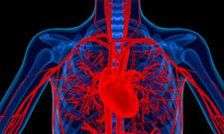New artery imaging technique

A team of scientists and clinicians across King’s Health Partners together with Lantheus Medical Imaging, Inc. have developed an exciting non-invasive imaging technique which tracks the build up of plaque in arteries, the main cause of cardiovascular disease leading to heart attack and stroke.
The new research by Makowski et al. published in Nature Medicine this week reports that a technique using Elastin-Specific Magnetic Resonance Contrast Agent (ESMA) is a step towards developing a painless, non invasive way to identify people who may be at risk of coronary heart disease before they show any symptoms. Current invasive procedures either fail to visualize the artery walls (such as X-ray) or risk damaging artery walls (for example, intravascular ultrasound).
The study which took two years and was funded by the British Heart Foundation, investigated the build up of plaque in mice arteries. The imaging works by using non-invasive radiation free MRI (magnetic resonance imaging) to identify the protein elastin which is abundant in artery walls. The contrast agent is first injected into the vein and then MRI makes the protein visible without exposing the animal to harmful radiation or requiring invasive catheterisation. As elastin production is increased during plaque development the ESMA technique clearly highlights the diseased sections of artery walls.
Professor Rene Botnar, who lead the research said: "The potential for this research to be translated from the laboratory into clinical practice is very exciting and we hope to develop a strategy together with our industrial partner, Lantheus Medical Imaging, to earlier identify patients with heart disease and to make them aware of their problem before they have a heart attack or stroke. Although there is still work to do before this imaging technique can be used in patients, in the future it could offer a better way to investigate the risk of large numbers of patients developing heart disease without subjecting them to X-ray radiation or an invasive procedure.
"Combined with conventional risk factors such as smoking, hypertension or high cholesterol, assessing plaque burden in this way could allow clinicians to make a more accurate decision about how to treat their patient best – for example choosing to suggest lifestyle changes or adapting their medical treatment."














